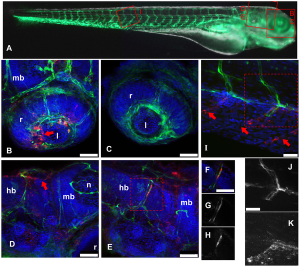One worthwhile way to study viruses – and other micro-organisms – is to see where exactly they are found within a host. How do they enter the body? What organs do they infect and how? How do they spread from tissue to tissue and organ to organ? How do they exit the body? These are just some of the questions which it would be good to actually SEE how and where it happens. Maybe then we could better understand the dynamic relationships governing infection and disease; maybe then we could design better, more effective therapies. Just maybe. Like it is all that easy.
 | |
| How could we track adenovirus movements? |
For one thing viruses are pretty small - so, are there any high resolution methods of looking at infection that may be able to help us? Pathologists can look at tissue samples from living or dead patients (animals included) and microscopically assess these for signs of viruses using for example: antibodies specific for particular proteins or nucleic acid probes (in situ hybridisation or PCR perhaps) found only in infected cells. This stuff is pretty good and is routinely used for both, clinical sciences and biological research but its kind of limited and in the last decade or so, the use of ‘reporter genes’ - like GFP and luciferase has facilitated the easier and faster analysis of viral infection.
Reporter genes are inserted into the viral genome and when expressed upon cell infection, they produce a protein – maybe a fluorescent or luminescent protein – whose function can be assayed and followed. This is what we can look at during infection. There are however certain limitations with this, in that, only those viruses that successfully infect a cell will express the reporter gene; viruses which fail to infect and are taken up by the liver or immune cells will not be detected. We are seeing a biased image of viral infection if we only consider reporter gene expression. This is particularly important when we are using viruses as therapeutic agents themselves as strict pharmacological testing requires intimate details of in vivo distribution and kinetics. So how can we see viruses in vivo without reporter genes?
As a paper in PLoS ONE, from a group at the Mayo Clinic in Rochester, demonstrates, there IS an alternative way to track viruses in vivo – the molecular attachment of individual reporter molecules to the virus itself thus requiring no gene expression and therefore allowing a more unbiased view of infection. An interesting aspect of this work is that it is carried out in real-time; these reporter molecules can be visualised as infection happens, at the millisecond scale. This also allows for the tracking at very early time points, times where no viral gene expression is taking place.
This study came at it from the angle of developing safer and more effective anticancer viruses, viruses which will infect and kill only those malignant cancer cells but this could be applied to any area of investigation. Being able to follow virus distribution in a mouse-model is of course a great scientific and clinical benefit to them. The group dyed an adenovirus vector with a molecule which emits light in the near-infrared range (particularly suited to in vivo imaging) which they then injected into groups of mice via their jugular vein. They were thus able to analyse and quantify the tissue distribution of their labelled vector throughout a whole mouse, in real-time.
This is the first time that this kind of imaging has been carried out and it certainly won’t be the last. This work could be applied to yet more viral vectors; it could be used to study a ‘natural’ infection or it could be used for non-viral imaging of therapeutic nanoparticles. A combination of this early time-point analysis with later, reporter gene expression imaging would be able to give us an unprecedented view into dynamic real-time viral infections in a number of model systems.
Brandenburg, B., & Zhuang, X. (2007). Virus trafficking – learning from single-virus tracking Nature Reviews Microbiology, 5 (3), 197-208 DOI: 10.1038/nrmicro1615
Hofherr, S., Adams, K., Chen, C., May, S., Weaver, E., & Barry, M. (2011). Real-Time Dynamic Imaging of Virus Distribution In Vivo PLoS ONE, 6 (2) DOI: 10.1371/journal.pone.0017076



















